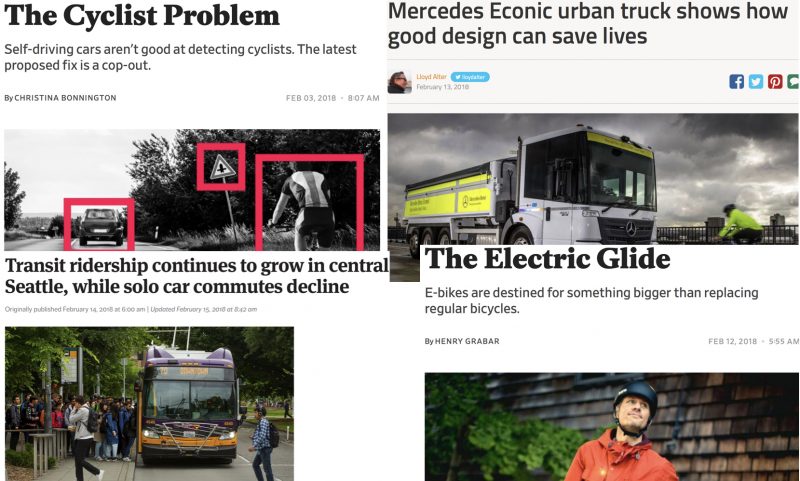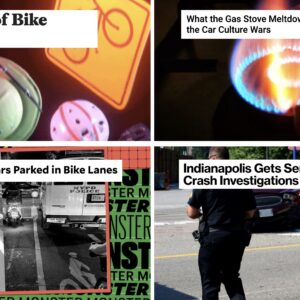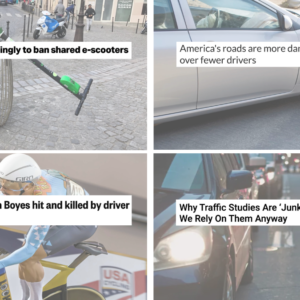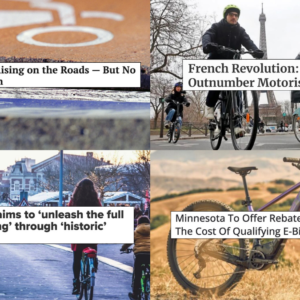
Welcome to the week.
We have just recovered from a pretty nasty battle with server bots and gremlins that took the site down last week. I apologize for the temporary lack of site access and then the lack of a comment section on many posts. Thankfully we appear to be past the problems (knocking on my wooden desk). Please let me know if you see something strange, and it don’t look good. One more thing… As part of those server issues, we’ve had to ditch our old “Related Posts” tool. We hope to find a replacement shortly.
Here are the most notable stories we came across in the past seven days…
Safer trucks for cities: Treehugger has the lowdown on a new model of Mercedes cement/garbage truck that was designed specifically to see other road users on crowded streetscapes.
The American “helmet fixation”: Newly published research from German scientist Gregg Culver makes a convincing case that America is less safe because of our “helmet fixation” which is “ultimately tied to the (re)production of unfettered automobility, and that it arguably hampers efforts to actually improve bicycle safety.”
Victim-blaming fixation: The city of Montclair, California has passed an ordinance banning the use of phones and earbuds while crossing the street.
Cars and Hollywood: What we see in films matters, and Mobility Lab says two reasons we see so much car use (and not transit) are ease of filming and product placement.
E-bikes akin to cars: Another week, another mainstream media article touting how awesome e-bikes are. This one is notable because of how it shifts the frame from seeing e-bike riders “cheaters” to seeing them as evolved drivers.
Advertisement
Seattle fights car abuse: Our neighbors to the north are celebrating transit ridership growth while drive-alone commute trips are falling. That’s the opposite of what’s happening in Portland.
Free transit in Germany: To reach pollution targets set by the EU, Germany is set to try free public transit in five of its cities.
ODOT and the ADA: 97 percent of the 26,000 curb ramps inspected in a survey conducted by Disability Rights Oregon did not meet ADA standards. (via The Oregonian)
More bad news about ODOT: The venerable Strong Towns podcast takes on none other than the Oregon Department of Transportation for their abysmal, auto-centric road designs that make tragedies inevitable.
Busiest bike bridge: Portland-based transportation planner Ray Delahanty crunched some numbers and ranked bike traffic volumes on North America’s bridges. Portland’s Hawthorne ranked only sixth. “Oh how the might have fallen,” Delahanty quipped.
It’s the automakers’ problem, not ours: New report states that bicycle users are “the most difficult detection problem” for self-driving cars — as if that’s somehow different than traditional cars.
— Jonathan Maus: (503) 706-8804, @jonathan_maus on Twitter and jonathan@bikeportland.org
Never miss a story. Sign-up for the daily BP Headlines email.
BikePortland needs your support.






Thanks for reading.
BikePortland has served this community with independent community journalism since 2005. We rely on subscriptions from readers like you to survive. Your financial support is vital in keeping this valuable resource alive and well.
Please subscribe today to strengthen and expand our work.
The Hawthorne bridge is the most memorable disappointment I had when I first moved to Portland. It quickly shattered the illusion that I was living in some sort of bicycle mecca.
First, there’s the narrow bike lane right beside an insanely high curb. Drivers would never be expected to drive right next to such a dangerous drop-off.
Then there’s the expectation that slower riders should merge in and out of the pedestrian traffic, which is stressful for both the people walking and biking.
And the icing on the cake was the absolute clusterfucks of the entrance and exit on the west side, where bikes are squeezed between rows of speeding cars and busses weaving in and out of the bike lane.
I’m impressed that the Hawthrone even made 6th place. When at all possible, I take the Morrison bridge, despite the steeper climb and the crappy door-zone bike lanes on Water Ave.
Does anyone else call this the looming deck surface on the Hawthorne the “cheese-grater”? No offense intended towards any new transplants from the great state of Wisconsin.
First time I rode my first motorcycle home from the guy I bought it from, I found myself floating on the Hawthorne deck grating – totally freaked out. It was a terrifying experience. Oh, to be 18 again.
RIP Mike Ford, who died on his bicycle on the Morrison Bridge in a construction zone.
Maybe the county should abandon FRP on the problem-plagued Morrison and revert to the cheese grater design. Especially since it functions as a freeway on/off ramp, the current deck only promotes even more excessive speed (which, I’m sure, in turn has promoted its rapid disintegration).
Same thing with the Hennepin Avenue bridge in Minneapolis. In the 1980s the old steel-decked bridge was replaced by a much more attractive design, but with a concrete deck and wider lanes. Not surprisingly, car speeds went way up. The new bridge isn’t too scary to bike on, despite 6 lanes of traffic, because the bike lanes are wide. But on the earlier bridge, biking on the steel deck wasn’t as scary as you might think, at least when it was dry, as long as traffic wasn’t heavy (no bike lanes on it back then), because drivers didn’t dare go very fast. Getting much over 20 mph was scary in a car on that thing.
Speaking of Minneapolis, I’m glad we got recognized for the #1 bike bridge in the country. And BTW, that upper deck of the Washington Avenue bridge (which also boasts a fully enclosed pedestrian passageway its entire length, as you can see in the photo) is one of three luxuriously wide bridges in central Minneapolis open only to nonmotorized users (the others being the Stone Arch and the #9/Dinkytown Greenway). Would it be too much to ask for Portland to have one bike-and-pedestrian bridge across the Willamette? (I’d almost count the path on the lower deck of the Steel, except it’s so skinny). Dream big!
Yeah, but the portals on the ends of the Morrison bridge are even crappier than the ones on the Hawthorne.
The bike detection problem for self driving cars is less of a problem than many make it out to be. Once the self driving cars arrive I plan to unfurl a good sized Lidar reflector on my backpack and take the lane. Robocars will assume I am a slow vehicle and just follow behind. Bike lanes will no longer be needed, as cars that follow the law meticulously will no longer pose a risk to cyclists.
Interesting to see if “the law” robocar follows is the speed listed on the sign or the currently institutionalized “10 over” going with the flow crap.
At least at present, drivers — even those whose cars have limited autonomy — are still in control of that to some extent. Just as a data point, the autopilot in a Tesla goes at whatever speed the driver selects up to a maximum of 5 over the limit.
It will be interesting to see how this changes as levels of autonomy increase.
And lets not get started on the biking conditions going over the I5 and I205 bridges…
ODOT’s out-of-compliance ADA curb cuts.
Wow.
First, how is it possible within a bureaucratic system to screw this up? There are no doubt detailed standards and people signing off at all stages. What is the explanation? The article does not even ask much less answer these questions.
Second, this:
“The state transportation department, under the settlement, agreed to put $23 million toward upgrading curb ramps in 2017 and 2018, and upgrade all of the inadequate ramps by the end of 2032.”
If I am not mistaken those are our tax dollars, which were mis-spent on non-compliant curb cuts and now we’re going to foot the bill the second time. I love ODOT. I hope I’m wrong and the $23 million are coming out of the pockets of those who signed off on the faulty work in the first place.
I think you’d find that the out-of-compliance curb cuts are mostly more than 30 years old. The ADA became law in 1990.
Early on there was not a lot of guidance on what the ADA meant and how to implement it. There were some of people who didn’t really care.
There are undoubtedly some screw-ups in recent years, but lots of people are working really hard to implement it. It’s actually rather difficult to meet the grades, spacing, etc while achieving adequate drainage, squeezing things into the existing rights of way, placing signal poles to avoid underground utilities, etc.
J_R that is really helpful. I wish the article had clarified this. Or, ODOT defended the situation by pointing this out. Journalism all too often leaves so much to be desired.
In fact, I think some of the rules–for instance the exact specifications for tactile warnings–may have changed even more recently. So some of the curb cuts that are out of compliance now may have been in compliance when built, even if built recently.
The compliance cases that bother me the most are ones where ODOT (or other jurisdictions per my comment below) just completely disregard accessibility. (That’s not to say that small deviations from meeting the requirements should be excused, because they can have big impacts on accessibility.)
The ADA law is ‘all or nothing’. Any part of a ramp that is not compliant, say 3 x 3 landings instead of 4 x 4, or 8.5% downgrade of a ramp instead of 8%, means the whole ramp in ‘noncompliant’.
Non-compliant does not equal unusable.
A journalist worth their salt might have shed a bit more light on the subtleties, wouldn’t you agree?
Are these additional $23 million dollars money well spent?
E-bike article- first sentence?
“Bicycles are the sharks of transportation, virtually unevolved through a century of technological upheaval in automobiles and airplanes.”
?!
Wheels, the sharks of transportation, virtually unevolved through 5,000 years of technological upheaval.
And paper. C’mon folks. So unevolved!
And what’s the deal with this bipedal locomotion?! Come on, our species has been walking this way for eons, even though technological advances have given us flight and mag-lev! Smh
Taking a cue from the OR ADA article:
…ODOTs new slogan for 2018, ‘our [roadways] are non-compliant [though that is OK, as they still are] functional, accessible and being used as intended.’
…or #ODOTnoncompliantisOK
I’ve never got involved with ODOT on ADA compliance, but I have with the Parks Bureau, which as we speak builds paths that don’t meet basic ADA standards. As an example people may know, the infamous short, new asphalt path that Parks and ODOT closed off with a black fence about a month ago in Willamette Park–it has expensive new ADA-compliant handrails immediately rendered non-compliant with bulky anti-skateboard collars, and no tactile warning where the trail leaves the park and crosses the tracks. The Willamette Greenway Trail continuing south from there to the Sellwood Bridge also was built without tactile warnings in the several places it crosses vehicle areas. Those were just recently installed after I had to argue with Parks that they were required, and even then it took several months. And the County, which built most of that trail, just didn’t care at all.
I can’t disagree that our helmet “fixation” is part of the car-head mentality and aids and abets a car-centric view of things. But to blame car-centrism on helmet fixation is to grossly underestimate how deeply ingrained automobility is here. Misguided efforts to make bicyclists more visible and crash-resistant are only a tiny piece of that puzzle.
Of course Seattle is seeing big transit ridership gains. They are currently making vast investments in their transit systems. They have a freaking subway now! The former bus tunnel now carries light rail trains from the airport – along with buses – not only across downtown from the International District to Westlake Center, but light rail now continues underground beneath Capitol hill all the way to the UW. Construction is currently underway on an extension from the UW up to Northgate, and a massive new line from downtown Seattle to Mercer Island and Bellevue. Seattle also now has six Rapid Bus lines, something TriMet has only in the planning stage.
This is not to say Seattle is ahead of Portland. Despite Rapid Bus, their rail system is still vastly underdeveloped for a city of their size. But they now have a voter-approved plan in place that will give them a world-class transit system by 2040.
It’s a far cry from 1996, when my wife and I left Seattle after rail transit failed that spring at the ballot for something like the twentieth time in the twentieth century. Ironically, our final act as citizens of Seattle was to vote yes on the November 2016 ballot that finally broke the spell and became the first of several successful transit measures, leading to the plan now in place. We were thrilled that first referendum finally succeeded, but for us it was too little and too late, and we’d already begun our transition to Portland. Despite our continued affection for Seattle, we never regretted the move.
Seattle is actually increasing density while Portland more or less talks about it in comparison. Portland can’t fathom running the worlds slowest light rail underground and thereby deleting the ridiculous 2 car trains.
Portland, you were amazing in 1989.
My own personal transportation revolution is going to be in the form of an ebike. Soon, my commute will be 32 miles round trip, four days a week. Going to attempt to tackle it on a Trek ebike. I’ve done ten and upwards of 20 miles round trip before on conventional roadbikes (for years at a time). I’m tired of being tired all the time…
https://www.trekbikes.com/us/en_US/bikes/hybrid-bikes/electric-hybrid-bikes/crossrip/crossrip/p/1373000-2018/?colorCode=black
It’s expensive, but I’m getting rid of my car…
Looks sweet.
“It’s expensive, but ”
I didn’t know they made safe deposit boxes that big…
My bike cost literally 1/10th of that and I’m still scared to park it in many locations. In fact, that’s my single biggest reluctance on ebikes. If they cost that much and I’m convinced that I won’t have a safe and secure location to park mine, I probably won’t take it.
We have a good number of e-bikes parked in the Lloyd bike garage. There are even outlets available!
Love the Montclair, California ordinance!
I have seen too many pedestrians walk straight across an intersection with earbuds in, with no hesitation and not even bothering to look either way before crossing. Don’t get me wrong. The pedestrian always has the right of way, but it doesn’t help them to be right if they are dead. Nobody is omniscient.
“These laws for pedestrians are absurd. What about deaf people? The blind?”
Hear, hear!
But doesn’t the law already say you can’t step out in front of cars unless you give them enough distance to react?
Also, if someone with earbuds looks before crossing, I don’t see any real danger. But it looks like the law would allow someone to be ticketed even if they look both ways and cross with nobody nearby coming from any direction, and for that matter even if they don’t have any sound turned on while crossing.
Also, what if someone is run over while talking on their phone while crossing the street under this law? Will the driver be excused, or partially excused?
Is there a law against crossing the street while drunk? Being drunk could impact your ability to cross safely as much or more than using earbuds or a phone.
What about crossing as a child, with child-level judgement? Or crossing while carrying a big box? Or with a poorly-trained big dog? Or wearing a rustling nylon hood in the rain that hampers your side vision and hearing?
How can you tell they didn’t look? Most people have >180 degree vision without moving their head. I always look, but you probably wouldn’t know.
When I played junior high basketball, our coach actually had us practice using our peripheral vision by moving our eyes but not our heads during the day, and we all did that. It was probably pretty weird-looking to other people, but it was great proof of what you and Paul noted.